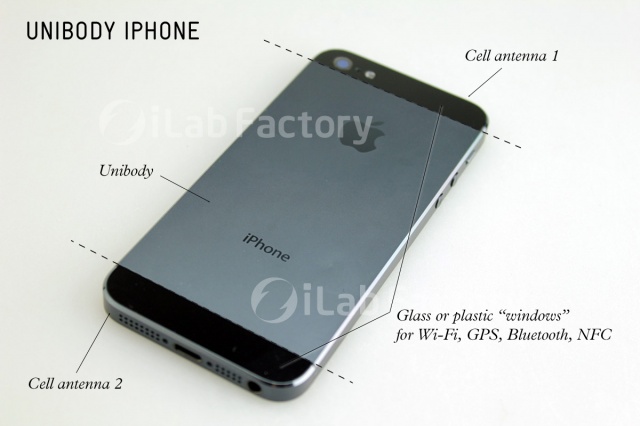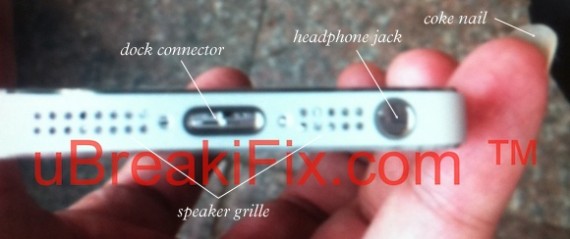Foarte multa lume s-a intrebat de ce iPhone 5 are o carcasa precum cea din imaginea de mai sus, unii spunand ca acest gen de imagini sunt false tocmai pentru ca prezinta o asemenea carcasa. Pe scurt, cele doua parti de plastic sau Gorilla Glass plasate in partea superioara/inferioara a carcasei ar ascunde de fapt antenele GSM/CMDA si antenele Wi-Fi, Bluetooth GPS, plus o eventuala antena NFC. Partea de aluminiu din mijloc este inclusa pentru a crestere duritatea dispozitivului si a impiedica ruperea sau craparea sa in cazul in care este scapat jos.
When the iPhone 4 first launched, it was a GSM-only phone, meaning it only worked on cell networks using the GSM standard. (AT&T, yes. Verizon, no.) The GSM iPhone 4 introduced the idea of an external metal-band antenna. It broke into two sections. One section for cell/data reception, and another section for GPS, Wi-Fi, and Bluetooth. This design worked but was also susceptible to a signal degradation if gripped in the wrong spot (aka Antennagate).
When the CDMA version of the iPhone 4 came out in February 2011, the design of the steel bands changed. This design would also carry over to the 4S. The 4S’s steel band is comprised of four pieces of steel: two U-shaped pieces at the top and bottom, and two long, flat pieces on the side. The steel sections don’t actually touch each other — they are separated by a .65mm piece of plastic. The way I understand the 4S cell antenna to work is this: There are two antennas, one at the top U bracket, and one at the bottom U bracket. The flat steel sides are only there to visually continue the metal band all the way around the phone and for structural reinforcement. The GPS, Wi-Fi, and Bluetooth antennas transmit out of the glass backplate. Long story short, instead of using the entire metal band for antennas like in the 4, the 4S only uses the top and bottom sections as antennas. Since the flat sides don’t contribute to transmitting signal and only help with the structure of the device, it makes sense to make them even more integral to the structure. This is what makes a unibody iPhone possible.
Teoria aceasta vine de la un designer industrial din Chicago care explica in detaliu pe blogul sau tot ceea ce am rezumat eu mai sus. Daca la iPhone 4S antenele sunt legate de benzile metalice de pe laterale, la iPhone 5 acele benzi laterale nu vor influenta in vreun fel antenele, ci portiunile din carcasa vor fi responsabile pentru toate antenele incluse in iPhone. Ca sa fiu sincer teoria pare credibila, mai ales ca alte motive credibile pentru includerea acelor portiuni de sticla/plastic nu exista.
Apple este singura care ne poate confirma veridicitatea acestei teorii, insa pana una alta eu cred ca este destul de exacta.
























